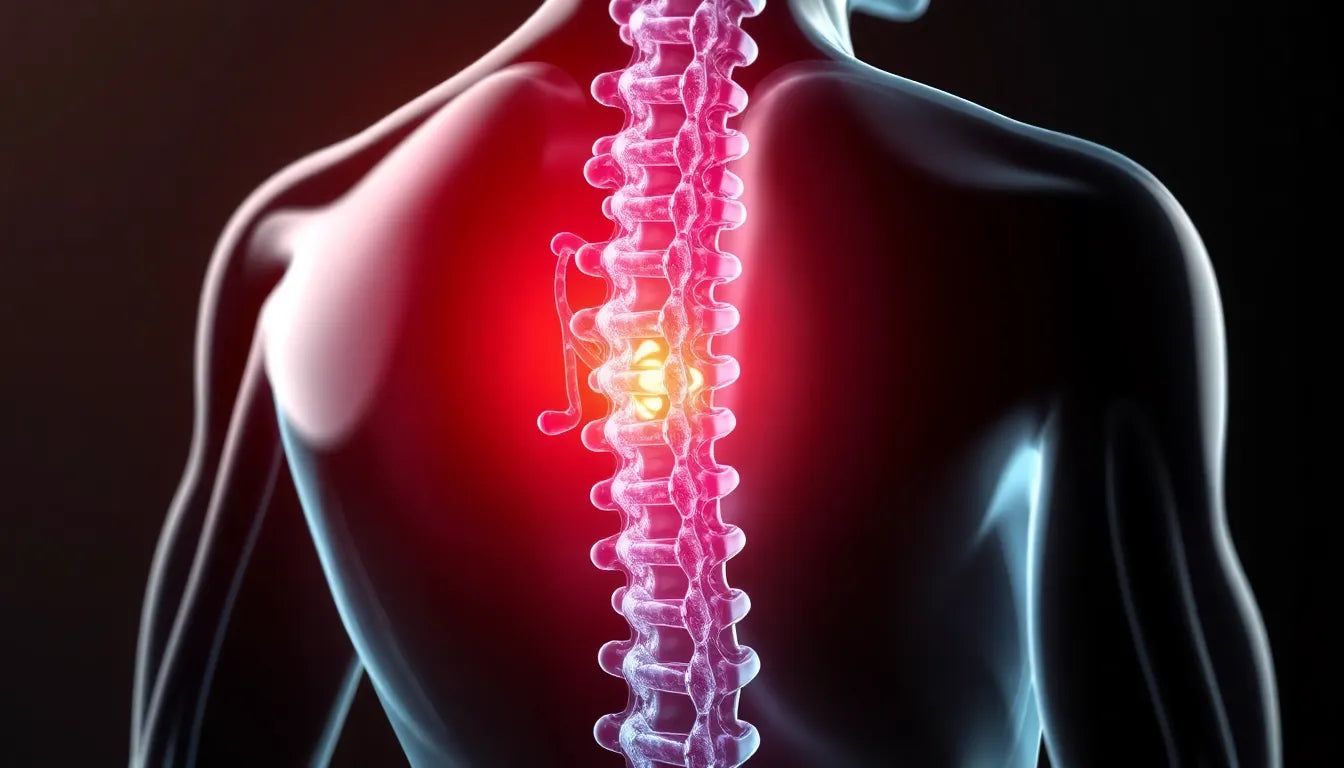Living with a herniated disc in the neck can be a daunting experience, especially when it comes to maintaining productivity and quality of life at work. Cervical disc herniation, a condition where the disc material in the neck protrudes and presses on nearby nerves, is not only a common ailment but also one that can significantly impact daily work life. The resulting neck pain can be debilitating, making it challenging to focus on tasks and perform effectively in professional settings.
Understanding cervical disc herniation
A herniated disc in the neck, medically referred to as cervical disc herniation, occurs when the soft inner gel of a cervical disc pushes through its tougher outer layer. This displacement can press on surrounding nerves, leading to symptoms such as neck pain, numbness, and weakness, which can radiate into the shoulders and arms. The condition is often the result of wear and tear over time, but it can also be triggered by sudden trauma or injury.
The importance of recognizing work-related factors
Understanding the relationship between work activities and cervical disc herniation is crucial for managing and preventing this condition. Certain occupational risk factors, such as repetitive neck movements or exposure to whole-body vibration, can exacerbate the symptoms or increase the likelihood of developing a herniated disc. By identifying these risk factors, individuals can take proactive steps to mitigate their impact, ensuring a healthier neck and a more comfortable work environment.
Recognizing the occupational hazards that could contribute to neck issues is essential for both employees and employers. This awareness can lead to the implementation of ergonomic interventions and workplace accommodations that promote neck health and prevent further injury. As we delve deeper into the intricacies of cervical disc herniation and its connection to work, it becomes clear that informed strategies and preventive measures are key to navigating work life with this condition.
delving into the medical research and statistics
When examining the relationship between a herniated disc in the neck and work, medical research provides valuable insights. A significant study from Denmark, which tracked over 850,000 workers across various occupations from 1981 to 2016, found no definitive link between increased risk of cervical disc herniation and certain occupational movements, such as neck flexion or angular velocity. This suggests that while some jobs may not directly cause herniation, other factors could still play a role in exacerbating the condition.
The prevalence of cervical disc herniation in adults is estimated between 0.5% and 2%, with the most affected levels being C5-C6 and C6-C7. This prevalence highlights the importance of awareness and proactive management, especially for individuals in high-risk occupations.
identifying occupational risk factors
While the Danish study didn't find a direct correlation with specific movements, certain job categories do show higher risk factors for cervical disc herniation. Male drivers in shipping and harbor jobs, for instance, have a standardized hospitalization ratio of 2.03 for prolapsed cervical discs. Similarly, workers in haulage and freight forwarding industries are at heightened risk, with an SHR of 1.04.
One of the significant risk factors identified is whole-body vibration (WBV), which is particularly prevalent among professional drivers. This occupational hazard can contribute to spinal issues, including cervical disc herniation. The ISO 2631-1 and ISO 2631-5 standards provide guidelines for assessing WBV exposure, emphasizing the need for protective measures in professions involving heavy machinery and prolonged driving.
the impact of whiplash and trauma
Another critical aspect to consider is the connection between whiplash injuries and cervical disc herniation. Studies indicate that 25% of individuals who suffer from whiplash develop herniated discs. Among these, 20% experience radicular symptoms, and 39% show abnormal cervical MRI findings. This underscores the need for careful monitoring and management of neck injuries, especially in occupations prone to such trauma.
occupational risk factors and standardized hospitalization ratios
| Occupation | Standardized Hospitalization Ratio (SHR) |
|---|---|
| Shipping and Harbor Drivers | 2.03 |
| Haulage and Freight Forwarders | 1.04 |
Understanding these occupational risk factors is crucial for both employees and employers. By recognizing the potential hazards, steps can be taken to implement ergonomic solutions and workplace adjustments that promote neck health and reduce the risk of cervical disc herniation.
In conclusion, while not all work-related activities directly cause cervical disc herniation, certain occupational factors can increase the risk or exacerbate existing conditions. By staying informed and proactive, individuals can better navigate their work life while managing the challenges of a herniated disc in the neck.
Treatment and recovery for cervical disc herniation
Managing a herniated disc in the neck effectively requires a comprehensive understanding of available treatment options and realistic recovery expectations. While the symptoms of cervical disc herniation can be disruptive, many individuals find relief through conservative treatment methods. Physical therapy is often recommended as a first-line approach, focusing on exercises that strengthen neck muscles and improve flexibility. Additionally, medications such as anti-inflammatory drugs and pain relievers can help manage discomfort during the healing process.
Recovery from a herniated disc in the neck varies among individuals, but many experience significant improvement within 4 to 6 months. During this period, it's crucial to adhere to a treatment plan that may include ergonomic adjustments at work and home. For those whose symptoms persist despite conservative measures, surgical options may be considered, although they are typically reserved for severe cases.
Preventing cervical disc herniation in the workplace
Prevention strategies play a vital role in minimizing the risk of cervical disc herniation, particularly in high-risk occupations. Ergonomic interventions, such as adjusting workstation setups to promote proper posture, can significantly reduce neck strain. Employers and employees alike should prioritize regular breaks to alleviate the physical demands of repetitive tasks and prolonged sitting.
For those in occupations involving whole-body vibration, such as professional drivers, implementing measures to reduce exposure is essential. This might include using vibration-dampening seats or adjusting driving techniques. By fostering a workplace culture that emphasizes neck health and safety, employers can help mitigate the risk factors associated with cervical disc herniation.
Frequently Asked Questions
What is a herniated disc in the neck?
A herniated disc in the neck, or cervical disc herniation, occurs when the soft inner substance of a cervical disc protrudes through its outer layer, potentially pressing on nearby nerves.
How can work affect a herniated disc in the neck?
Certain occupational activities, particularly those involving whole-body vibration or repetitive neck movements, can exacerbate the condition, leading to increased discomfort and symptoms.
What are the symptoms of a cervical herniated disc?
Common symptoms include neck pain, arm pain, numbness, and weakness, which may radiate into the shoulders and arms.
How is a cervical herniated disc diagnosed?
A cervical herniated disc is diagnosed through a combination of clinical evaluation, imaging tests like MRI, and an assessment of the patient's symptoms.
What treatments are available for a herniated disc in the neck?
Treatment options include physical therapy, medications to relieve pain and inflammation, and in some cases, surgical intervention if conservative treatments are ineffective.
Can I continue working with a herniated disc in the neck?
Many individuals can continue working with appropriate accommodations and treatment. It's important to discuss your specific situation with a healthcare professional to determine the best approach for managing your condition while maintaining productivity at work.
Sources
- "Prospective, population-based study of occupational movements..." (2022). PMC.
- "Disc Herniation." NCBI StatPearls.
- "Disc Herniation." Physiopedia.
- "Trauma Series #24 - Whiplash & Disc Herniation Statistics" (2024). Vancouver Disc Center.
- "An investigation of a cluster of cervical herniated discs among..." JSTOR.
- "Cervical Herniated Disc Symptoms and Treatment Options." Spine-Health.


















